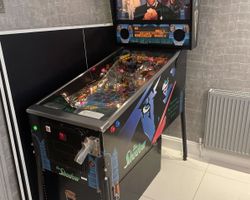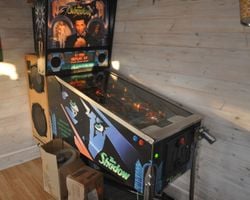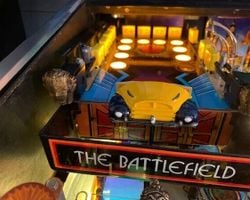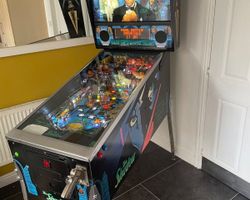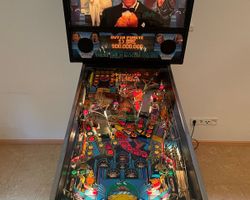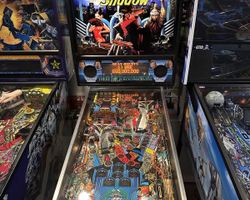The Shadow
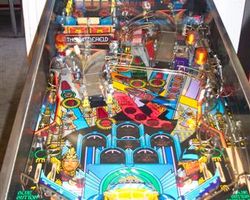
Average Prices: USD $800 to $3,100
Produced: November, 1994
Production Run: 4,247 units
Machine Type: Solid State Electronic
MPU: Williams WPC Security (WPC-S)
Players: 4
Design by: Brian Eddy
Art by: Doug Watson
Dots/Animation by: Scott Slomiany, Eugene Geer
Mechanics by: Robert C. Friesl
Music by: Dan Forden
Sound by: Dan Forden
Software by: Mike Boon, Brian Eddy
"The Shadow," a pinball machine released by Bally in November 1994, remains a compelling, albeit somewhat enigmatic, title in pinball history. Born from the namesake film, this game, designed during the WPC-S era, offers a rich tapestry of gameplay and innovative features that continue to captivate players, even as opinions on its thematic execution remain varied.
History and Background
Bally Manufacturing Co. introduced "The Shadow" to arcades and homes during the bustling pinball landscape of the mid-1990s. Inspired by the 1994 film adaptation of the classic pulp fiction character, the pinball machine aimed to capture the dark, mysterious world of The Shadow and his battle against evil. The game emerged from the creative minds of a talented team. Brian Eddy, in his debut as a playfield designer, spearheaded the project, laying the foundation for a celebrated career that would later include titles like "Attack from Mars" and "Medieval Madness." Doug Watson lent his artistic talents to the game's visuals, while Dan Forden crafted the music and sound, and Mike Boon developed the software. Tim Kitzrow, known for his voice work in sports games, provided the distinctive callouts, embodying the persona of The Shadow himself.
Production of "The Shadow" commenced in November 1994, with a confirmed run of 4,247 units. Despite its association with a film that did not achieve widespread acclaim, the pinball machine quickly carved out its own niche. Interestingly, some design elements initially conceived for "The Shadow" found later life in Eddy's subsequent, highly successful designs, hinting at the game's role as a creative incubator. A hidden "Secret Laughter Mode," triggered by a specific sequence of actions involving the gun trigger and targets, adds a layer of playful mystique for dedicated players to uncover. Furthermore, the manufacturer acknowledged a potential mechanical weakness, issuing a repair kit to address a fragile plastic gear within the Battlefield mini-playfield, proactively replacing it with a more durable brass component – a testament to their commitment to machine longevity even post-release.
Signature Features and Design
"The Shadow" distinguishes itself through several standout features that elevate the gameplay experience beyond typical pinball fare. The most visually striking is the elevated Battlefield mini-playfield, a unique play area reminiscent of the classic video game "Breakout." Here, a player-controlled paddle, guided by flipper buttons and utilizing an optic sensor, deflects pinballs, adding a distinct video game-like mini-game within the pinball environment.
Another hallmark is the "Sanctum" magnet ball lock, a mesmerizing mechanism where a magnet beneath the playfield captures and secures pinballs, creating a visually engaging effect as balls are prepared for multiball modes. The inclusion of player-controlled ramp diverters, shaped like Phurbas (Indian daggers), on both ramps allows for strategic redirection of pinballs, offering players a degree of control over shot outcomes rarely seen. Finally, the electric plunger, fashioned as a gun-shaped shooter handle, provides a tactile and thematic launch mechanism, immersing players further into The Shadow's world from the very first ball. These features combine to create a pinball experience that is both visually and mechanically rich, setting "The Shadow" apart from many of its contemporaries.
Playfield and Mechanics
The playfield of "The Shadow" is a complex and engaging landscape, designed to encourage skillful shooting and strategic decision-making. It features two ramps, each equipped with player-controlled diverters, enabling dynamic shot selection. A crucial element is the drop target situated in front of the vertical up-kicker (VUK), which, when knocked down, grants access to launch balls onto the elevated Battlefield mini-playfield. This multi-leveled playfield design adds verticality and varied gameplay areas, moving beyond a purely horizontal plane.
The absence of traditional pop bumpers is notable, replaced by kick-out holes and strategic target placement, contributing to a faster and more flowing game. The artwork and lighting on the playfield are designed to evoke a shadowy, mysterious atmosphere, aligning with the game's theme. However, opinions on the execution of the artwork are divided within the pinball community. The overall aesthetic, while thematically consistent, has been described by some as dark or less visually appealing compared to other pinball machines of the era. Despite this, the playfield layout itself is widely praised for its flow and the integration of its unique mechanisms.
Gameplay Dynamics
"The Shadow" offers deep and engaging gameplay dynamics, characterized by a multi-layered scoring system and a variety of modes and objectives. The game is known for its five multiball modes, each themed around different aspects of The Shadow's world, providing ample opportunities for high scores and frenetic action. Reaching the wizard mode requires dedicated play and mastery of the game's various objectives.
The Battlefield mini-game is not just a visual spectacle but also a crucial component of gameplay, offering unique scoring opportunities and challenges. The player-controlled diverters introduce a strategic element, allowing for skillful redirection of balls to access different playfield areas and modes. The magnet ball lock in the Sanctum is integral to initiating multiball sequences, adding an element of anticipation and excitement as balls are captured and released. A video mode, involving dodging falling knives, provides a brief change of pace and another avenue for scoring bonuses. The game's ruleset is considered deep and rewarding, offering high replayability as players strive to master its nuances and unlock all its secrets.
Reception and Legacy
"The Shadow" has garnered a largely positive reception within the pinball community, praised for its innovative gameplay and unique features. Many players consider it an underrated gem, citing its smooth flow, challenging shots, and deep ruleset as key strengths. The Battlefield mini-playfield and the Sanctum magnet lock are consistently highlighted as standout elements that contribute to the game's distinctiveness and enjoyment. The sound and music are also generally well-regarded for enhancing the thematic immersion.
However, criticisms often center on the game's theme and artwork. The association with the less successful "Shadow" movie is frequently mentioned as a potential factor limiting broader appeal. Some find the artwork, particularly the backglass and playfield graphics, to be aesthetically unappealing or thematically muddled. Despite these artistic critiques, the gameplay mechanics and overall design of "The Shadow" have secured its place as a respected and sought-after machine among pinball enthusiasts. Its influence can be subtly traced in subsequent pinball designs, particularly in Brian Eddy's later works, demonstrating its significance as a creative stepping stone in pinball development. "The Shadow" remains a testament to innovative pinball design, proving that compelling gameplay can often transcend thematic preferences and secure a lasting legacy.
 Active Auctions
Active Auctions
 Auction Results
Auction Results
| Cost | Location | Date |
|---|---|---|
| GBP £2,500 |  Poole, United Kingdom Poole, United Kingdom |
09 April, 2025 |
| USD $6,000 |  California, United States California, United States |
21 March, 2025 |
| USD $4,500 |  Indiana, United States Indiana, United States |
15 March, 2025 |
| USD $5,100 |  Indiana, United States Indiana, United States |
12 February, 2025 |
| USD $6,500 |  Florida, United States Florida, United States |
05 January, 2025 |
| GBP £2,550 |  United Kingdom United Kingdom |
18 November, 2024 |
| USD $6,000 |  Arizona, United States Arizona, United States |
17 October, 2024 |
| USD $4,950 |  Nebraska, United States Nebraska, United States |
17 September, 2024 |
| USD $5,700 |  Michigan, United States Michigan, United States |
15 August, 2024 |
| USD $5,600 |  Massachusetts, United States Massachusetts, United States |
22 June, 2024 |


Private Policy · Search Website · Contact Us
All trademarks and copyrighted materials remain property of their respective owners.
All other content copyright 2007 - 2025 Pinpedia.

